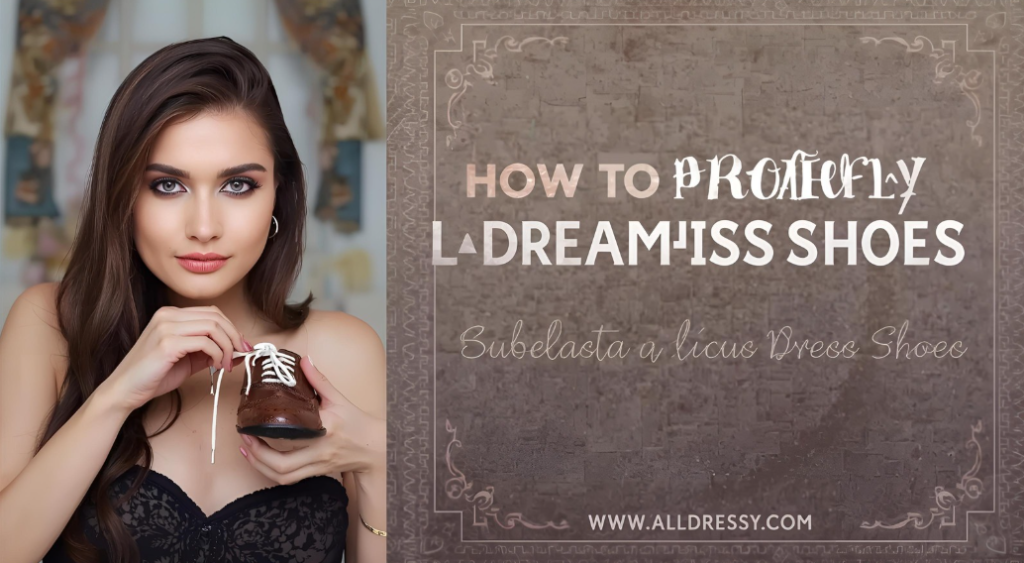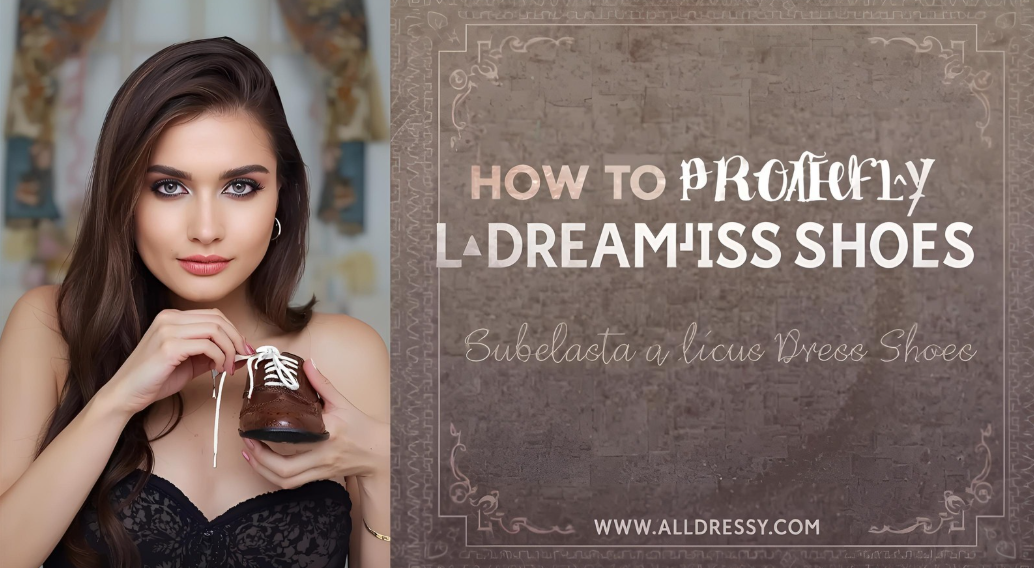Shoes are often the first thing people notice in an outfit, and when it comes to formalwear, dress shoes play a major role in shaping your overall impression. Whether you’re preparing for a wedding, a business meeting, or a black-tie event, the way you lace your shoes can significantly impact not only your appearance but also your comfort. Many people overlook this detail, yet learning how to properly lace dress shoes ensures a polished, elegant look while keeping your feet secure and comfortable throughout the day.
In this comprehensive guide, we’ll break down everything you need to know about lacing dress shoes correctly—covering classic techniques, modern variations, common mistakes, and expert tips. By the end, you’ll understand not only the best way to lace dress shoes but also how different lacing methods can enhance both your style and comfort.
Why Properly Lacing Dress Shoes Matters

Before diving into techniques, let’s explore why proper lacing is essential:
- Aesthetic Appeal – Dress shoes are designed with elegance in mind, and neat lacing contributes to a refined look.
- Foot Comfort – Proper lacing distributes pressure evenly, reducing discomfort during long hours of wear.
- Shoe Longevity – Correct lacing prevents strain on eyelets and leather, extending the life of your shoes.
- Confidence Boost – Knowing your shoes look sharp enhances your self-assurance in formal settings.
Understanding Dress Shoe Types and Eyelets
To master how to properly lace dress shoes, it’s important to recognize the types of dress shoes and their lacing systems.
Oxford Shoes
- Feature closed lacing with stitched eyelets under the vamp.
- Known for a sleek, formal appearance.
- Often require straight-bar lacing for a traditional finish.
Derby Shoes
- Use open lacing with eyelets sewn on top of the vamp.
- Slightly less formal but easier to adjust.
- Work well with both criss-cross and straight-bar lacing.
Brogues
- Decorative perforations add texture and style.
- Can be laced in versatile ways depending on the level of formality.
Monk Straps (Not Laced, but Relevant)
- Though not traditionally laced, understanding them helps differentiate lace-free dress shoe styles.
Dress Boots
- Often feature additional eyelets or speed hooks.
- Can be laced with a mix of formal and functional techniques.
Tools and Preparations Before Lacing
Before you begin, make sure you have the right essentials:
- A clean pair of laces (preferably waxed cotton for formal shoes).
- Even lace lengths on both sides.
- A flat, well-lit surface to work on.
- Polished shoes for best presentation.
Step-by-Step: How to Properly Lace Dress Shoes
1. Straight Bar Lacing (European or Fashion Method)
This is the most common method used on Oxford shoes for a formal and symmetrical look.
Steps:
- Insert the lace through the bottom eyelets, with both ends emerging inside the shoe.
- Take one end and thread it straight across to the opposite eyelet on the outside.
- Feed it up the inside and out through the next eyelet.
- Repeat with the other lace, alternating bars until the top is reached.
Best For: Weddings, black-tie events, and professional meetings.
2. Criss-Cross Lacing (Standard Method)
The most common and practical lacing style, used for both casual and formal occasions.
Steps:
- Begin with the lace threaded evenly through the bottom eyelets.
- Cross the laces diagonally and insert them into the next pair of eyelets.
- Continue in a zigzag pattern until the top is reached.
Best For: Derby shoes, brogues, and semi-formal wear.
3. Hidden Knot Lacing (Elegant Finish)
This method hides the knot inside the shoe for an ultra-clean look.
Steps:
- Use straight bar lacing until the last eyelet.
- Tie the knot inside the shoe tongue.
- Tuck the ends neatly for a seamless appearance.
Best For: High-fashion formalwear and stage performances.
4. Diagonal Lacing (Creative and Stylish)
A more modern, stylish method that adds flair to dress shoes.
Steps:
- Start with one lace going straight across at the bottom.
- Cross diagonally skipping one eyelet each time.
- Continue until the top, creating angled lines.
Best For: Dress boots or creative formal outfits.
5. Military or Ladder Lacing (Secure Fit)
A strong and structured method, suitable for boots or when you need added support.
Steps:
- Start with a straight lace at the bottom.
- Run both ends vertically on the inside, then cross them over horizontally.
- Repeat until reaching the top eyelets.
Best For: Dress boots, work functions requiring long wear, or marching events.
Choosing the Right Laces for Dress Shoes
1. Material
- Waxed Cotton – Best for dress shoes; maintains a polished look.
- Leather Laces – Stylish but less common in formal shoes.
- Synthetic Laces – Affordable but less elegant.
2. Length
- Oxfords typically require 28–30 inch laces.
- Derbies and brogues need 30–34 inches.
- Boots may need 40+ inches.
3. Color
- Match laces with shoe color for classic formality.
- Experiment with subtle contrasts (e.g., navy laces on brown shoes) for a stylish twist.
Common Mistakes When Lacing Dress Shoes
- Uneven Lace Lengths – Creates imbalance and looks unpolished.
- Wrong Lacing Style for Shoe Type – Straight bar lacing on Derbies, for example, can look awkward.
- Using Athletic Laces – Thick, round laces ruin the elegance of dress shoes.
- Loose Lacing – Can cause discomfort and reduce shoe support.
- Overly Tight Lacing – Damages leather and causes foot pain.
Styling Tips: Matching Lacing with Outfits
- Business Formal – Use straight bar lacing with black or dark brown laces.
- Smart Casual – Criss-cross lacing with subtle contrast laces works well.
- Wedding/Events – Hidden knot or straight lacing provides a sleek finish.
- Creative Outfits – Diagonal or colorful laces can add personality while maintaining elegance.
Caring for Dress Shoe Laces
- Regular Cleaning – Remove laces and wash with mild soap.
- Replacement – Change laces every 6–12 months for a fresh look.
- Storage – Keep extra laces handy in a drawer or shoe care kit.
Advanced Lacing Variations for Dress Shoes
Gap Lacing
Leaves a gap down the center for added comfort and breathability.
Over-Under Lacing
Alternates over and under passes, reducing lace wear and friction.
Double Helix Lacing
Creates a stylish twisted effect, suitable for semi-formal looks.
Lacing Dress Shoes for Different Foot Shapes
- Wide Feet – Use gap lacing for extra room.
- High Arches – Loose criss-cross lacing reduces pressure.
- Narrow Feet – Straight bar lacing with tighter tension works best.
History of Dress Shoe Lacing
The art of how to properly lace dress shoes has evolved from practical needs to fashion statements. Early shoes in the 17th century used simple ties, while the Victorian era refined lacing methods for elegance. Today, the right lacing reflects both tradition and personal style.
Final Thoughts
Mastering how to properly lace dress shoes is more than just a small detail—it’s a reflection of your attention to style and presentation. From the timeless straight bar method for Oxfords to creative diagonal lacing for modern looks, choosing the right lacing style can transform your appearance. Whether for comfort, elegance, or individuality, proper lacing ensures your dress shoes not only look their best but also provide lasting comfort.
Frequently Asked Questions (FAQs)
1. What is the most formal way to lace dress shoes?
The straight bar (European) lacing method is considered the most formal. It creates clean horizontal lines across the shoe, making it ideal for Oxfords at weddings, black-tie events, or business occasions.
2. Can I use criss-cross lacing on Oxford shoes?
You can, but it is less formal and may look casual. Criss-cross lacing works better with Derby shoes, brogues, or semi-formal footwear.
3. How long should laces be for dress shoes?
For standard Oxfords, 28–30 inches is sufficient. For Derbies or brogues, 30–34 inches is recommended. Taller dress boots may require 40 inches or more.
4. Should I match my shoelace color to my shoes?
Yes, for formal occasions, match the laces to the shoe color (black with black, brown with brown). For casual or creative looks, subtle contrasts like navy on brown shoes can add personality.
5. How do I keep my dress shoe laces looking neat?
Choose waxed cotton laces, which hold shape better and resist fraying. Replace laces regularly, avoid over-tightening, and clean them with mild soap when dirty.
6. Can lacing affect shoe comfort?
Absolutely. Proper lacing evenly distributes pressure across the foot, prevents tight spots, and ensures better support, especially for people with wide feet, narrow feet, or high arches.
7. What lacing method hides the knot?
The hidden knot method tucks the knot inside the shoe tongue for a seamless, elegant finish. This is popular in high-fashion looks or stage performances.
Conclusion
Learning how to properly lace dress shoes may seem like a minor detail, but it has a significant impact on both style and comfort. The right lacing method—whether straight bar for formality, criss-cross for versatility, or hidden knot for elegance—completes your outfit and shows attention to detail. Proper lacing not only improves shoe aesthetics but also enhances comfort by reducing pressure and keeping your feet secure.
From choosing the right length and material of laces to matching them with your outfit, every step contributes to a refined look. Whether you’re attending a wedding, heading to the office, or dressing smart for a night out, your shoes set the tone for your style. By mastering these lacing techniques, you ensure that your dress shoes remain polished, comfortable, and ready to make the best impression.

